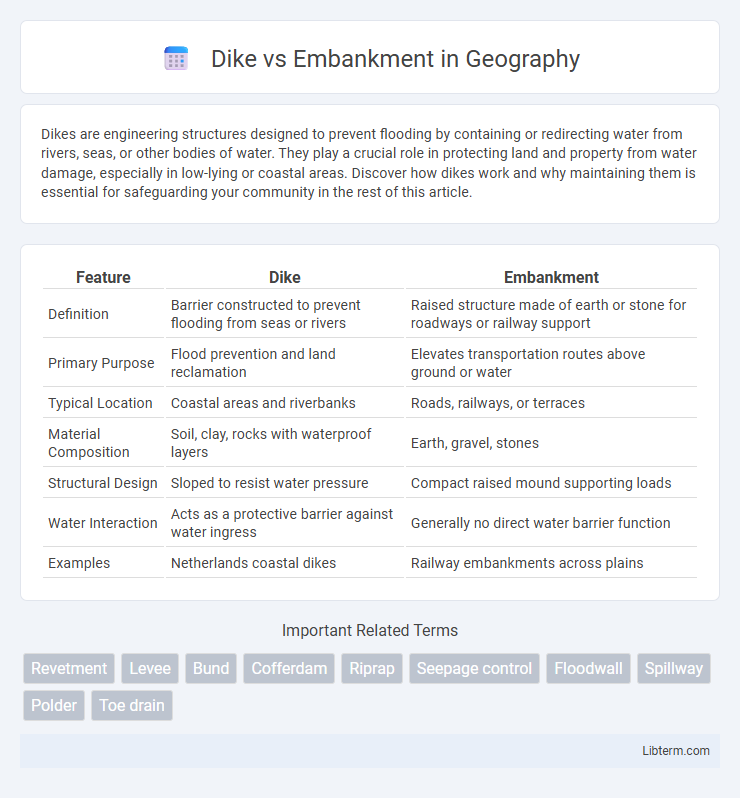Dikes are engineering structures designed to prevent flooding by containing or redirecting water from rivers, seas, or other bodies of water. They play a crucial role in protecting land and property from water damage, especially in low-lying or coastal areas. Discover how dikes work and why maintaining them is essential for safeguarding your community in the rest of this article.
Table of Comparison
| Feature | Dike | Embankment |
|---|---|---|
| Definition | Barrier constructed to prevent flooding from seas or rivers | Raised structure made of earth or stone for roadways or railway support |
| Primary Purpose | Flood prevention and land reclamation | Elevates transportation routes above ground or water |
| Typical Location | Coastal areas and riverbanks | Roads, railways, or terraces |
| Material Composition | Soil, clay, rocks with waterproof layers | Earth, gravel, stones |
| Structural Design | Sloped to resist water pressure | Compact raised mound supporting loads |
| Water Interaction | Acts as a protective barrier against water ingress | Generally no direct water barrier function |
| Examples | Netherlands coastal dikes | Railway embankments across plains |
Introduction: Understanding Dikes and Embankments
Dikes and embankments are critical structures designed to manage water flow and prevent flooding in coastal and riverine areas. A dike is typically an elongated barrier constructed from earth or stone to hold back seawater or river water, while an embankment is a raised mound built to support roads, railways, or to contain water bodies. Both play essential roles in flood control, land reclamation, and infrastructure protection, with their design criteria influenced by environmental factors and engineering requirements.
Definitions: What is a Dike? What is an Embankment?
A dike is a man-made structure built primarily to prevent flooding by holding back water from rivers, seas, or lakes. An embankment is an engineered mound of earth or stone designed to support roads, railways, or act as a barrier against water or soil erosion. While both are constructed barriers, dikes are specifically flood-protection systems, whereas embankments serve broader purposes including transportation infrastructure support.
Historical Background of Dikes and Embankments
Dikes and embankments have been essential structures in water management and flood control since ancient civilizations such as Mesopotamia and the Netherlands, where early societies built them to reclaim land and protect settlements from rising waters. The Dutch pioneered complex dike systems in the Middle Ages, incorporating layered earthworks and sluices, setting a foundation for modern hydraulic engineering. Embankments evolved as raised barriers along riverbanks and coastlines, often constructed from locally sourced materials, to contain floods and navigate changing landscapes throughout history.
Key Functions and Purposes
Dikes primarily serve to prevent flooding by acting as barriers that hold back water from rivers, seas, or lakes, protecting inhabited and agricultural land. Embankments function to elevate roads, railways, or flood defenses above surrounding ground levels to ensure accessibility and mitigate water intrusion. Both structures are essential in water management and land reclamation, but dikes focus on water containment while embankments emphasize elevation and protection.
Structural Differences Between Dikes and Embankments
Dikes are engineered barriers specifically designed to prevent floods by holding back water, often constructed with impermeable cores and reinforced slopes to resist hydraulic pressure. Embankments are raised earth structures primarily built for transportation or land reclamation, featuring compacted soil layers optimized for load-bearing rather than water resistance. The main structural difference lies in dikes' focus on waterproofing and erosion control, whereas embankments prioritize stability and uniform compaction for supporting vehicles or infrastructure.
Materials Used in Construction
Dikes are primarily constructed using compacted earth, clay, and sand, which provide structural strength and impermeability to prevent water seepage. Embankments, on the other hand, often incorporate a wider range of materials such as gravel, rockfill, concrete, and even synthetic geomembranes to enhance stability and durability in varying environmental conditions. Both structures require careful selection of materials based on soil properties, water pressure, and intended load-bearing capacity to ensure effective flood protection.
Design and Engineering Considerations
Dike design emphasizes height and slope stability to prevent water overflow and erosion, requiring materials like compacted earth or rock fill and incorporating drainage systems to relieve hydrostatic pressure. Embankment engineering prioritizes foundational integrity through soil investigation and reinforcement techniques such as geotextiles or soil nails to support heavy loads and resist settlement. Both structures demand careful analysis of hydrological data, load conditions, and environmental impact to ensure long-term durability and safety against flooding events.
Applications in Flood Management
Dikes and embankments serve critical roles in flood management by preventing water overflow from rivers, lakes, or seas into inhabited areas. Dikes, typically constructed from earth or stone, are used to protect low-lying regions such as the Netherlands, effectively controlling tidal and river flooding. Embankments, often elevated and reinforced, are implemented along riverbanks and floodplains to contain seasonal floodwaters and minimize damage in urban and agricultural zones.
Advantages and Disadvantages: Dikes vs. Embankments
Dikes offer strong flood protection by creating continuous barriers against water flow, making them highly effective in coastal and riverine flood management, but their construction can be costly and may disrupt natural water ecosystems. Embankments provide flexibility and are easier to build using locally available materials, offering moderate flood defense, though they often require more maintenance and are vulnerable to erosion and seepage. Both structures require careful design to balance flood protection with environmental impact and long-term sustainability.
Case Studies and Real-World Examples
Case studies comparing dikes and embankments reveal distinct performance in flood protection and environmental impact. The Netherlands' Delta Works uses dikes extensively to safeguard low-lying areas from the North Sea, demonstrating high resilience against storm surges. In contrast, the Mississippi River's embankments have faced challenges with strength and maintenance, leading to significant flooding events and prompting ongoing reinforcement projects.
Dike Infographic

 libterm.com
libterm.com